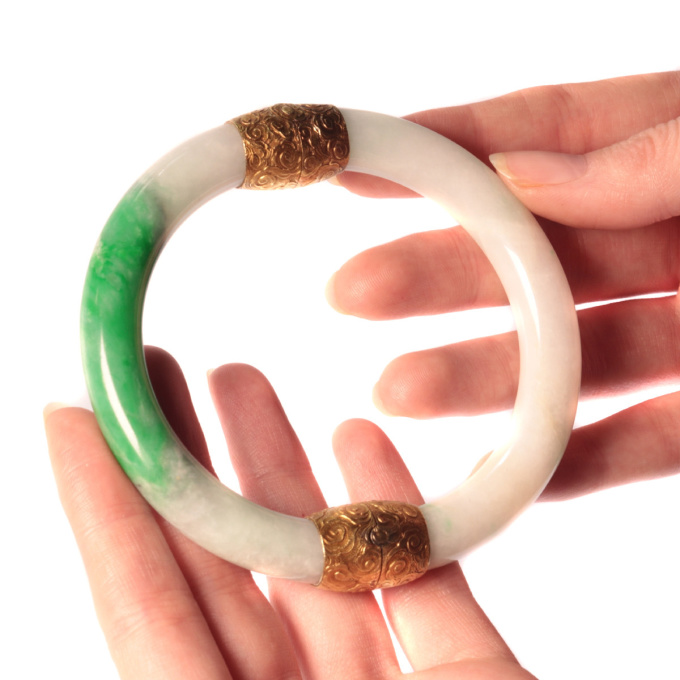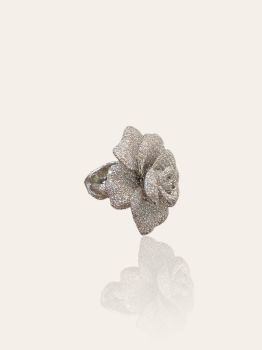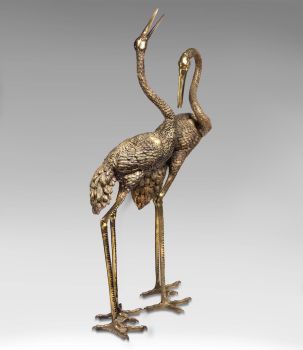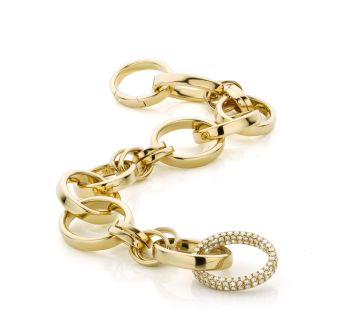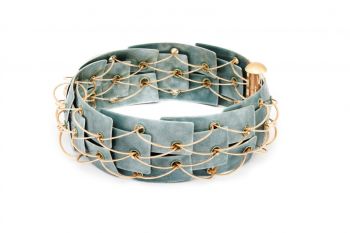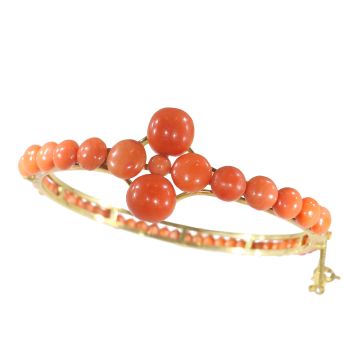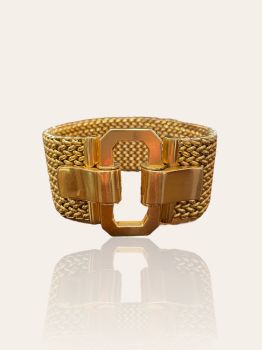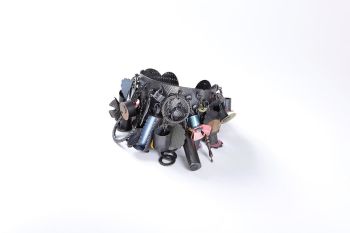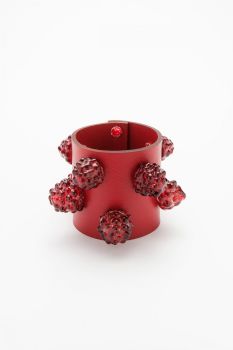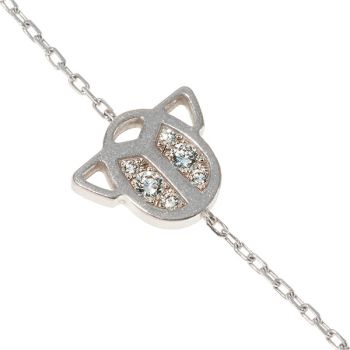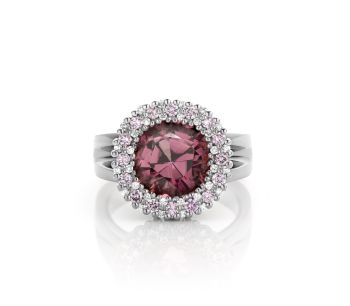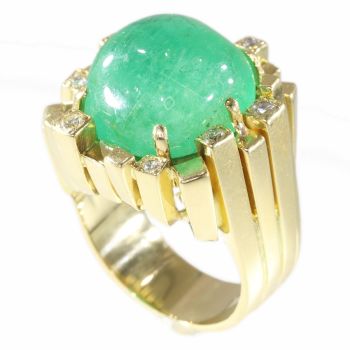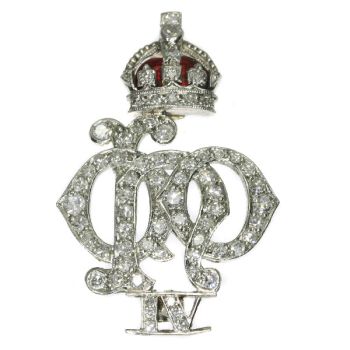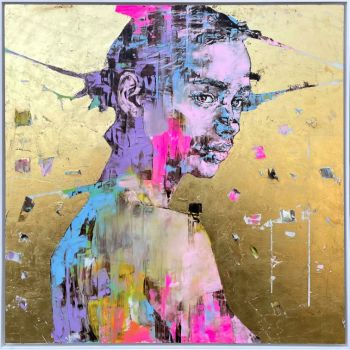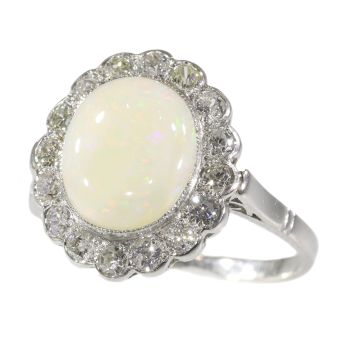Victorian A-jade certified bangle with 18K gold closure and hinge 1880
Unknown artist
GoldJadeGemstone
Currently unavailable via Gallerease
- About the artwork
Antique jewelry object group: bangle
Condition: very good condition
- (more info on our condition scale)
Country of origin: unknown, China?
Style: Victorian - Victorian decorative arts refers to the style of decorative arts during the Victorian era. The Victorian era is known for its eclectic revival and interpretation of historic styles and the introduction of cross-cultural influences from themiddle east and Asia in furniture, fittings, and Interior decoration. Victorian design is widely viewed as having indulged in a regrettable excess of ornament. The Arts and Crafts movement, the aesthetic movement, Anglo-Japanese style, and Art Nouveaustyle have their beginnings in the late Victorian era.
- See also: Victorianor more info on styles
Style specifics: The Romantic Victorian Period - Experts divide the reign of Queen Victoria, also called The Victorian era (1837 - 1901) in to three periods of about twenty years each; The Romantic Victorian Period (1837 - 1860), The Grand Victorian Period (1860 -1880), and the Late or Aesthetic Victorian Period (1880 - 1901).
We consider this to be of the Romantic Victorian Period. This period covers the coronation of Victoria as Queen of Great Britain and Ireland, and her marriage to King Albert and their love, their devotion to their marriage and to their country are thesources of inspiration for this period. The jewels of this period are made of intricate carvings, special techniques where the enamel is subtly worked. These techniques allowed to give the jewel a certain opulence with less precious metal needed. Asprecious metals were really rare at that time. Highly favored (semi-) precious stones in this period are amethyst, coral, garnets, seed pearls and turquoises. The connotation is obviously sentimental, symbolic and romantic with reminiscent Gotic and/orRenaissance patterns and an abundant use of motifs like anchors, birds, branches, crosses, hearts and snakes.
Period: ca. 1880
- (events & facts of this era, poetry of this era, fashion of this era)
Material: 18K yellow gold (touchstone tested)
- (more info on precious metals)
Extra information: Jade - Jade refers to an ornamental mineral, mostly known for its green varieties. It can refer to either of two different minerals: nephrite, a silicate of calcium and magnesium, or jadeite, a silicate of sodium and aluminium.
Jade is featured prominently in ancient Asian art, but also has an important place in many other cultures.
In the history of the art of the Chinese empire, jade has had a special significance, comparable with that of gold and diamonds in the West. Jade was used for the finest objects and cult figures, and for grave furnishings for high-ranking members of theimperial family. Due to that significance and the rising middle class in China, in 2010 the finest jade when found in nuggets of "mutton fat" jade – so-named for its marbled white consistency – could sell for $3,000 an ounce, a tenfold increase from adecade previously.
Jade may be enhanced (sometimes called "stabilized"). Some merchants will refer to these as grades, but degree of enhancement is different from colour and texture quality. In other words, Type A jadeite is not enhanced but can have poor colour andtexture. There are three main methods of enhancement, sometimes referred to as the ABC Treatment System:
Type A jadeite has not been treated in any way except surface waxing.
Type B treatment involves exposing a promising but stained piece of jadeite to chemical bleaches and/or acids and impregnating it with a clear polymer resin. This results in a significant improvement of transparency and colour of the material. Currently, infrared spectroscopy is the most accurate test for the detection of polymer in jadeite.
Type C jade has been artificially stained or dyed. The effects are somewhat uncontrollable and may result in a dull brown. In any case, translucency is usually lost.
B+C jade is a combination of B and C: it has been both impregnated and artificially stained.
Type D jade refers to a composite stone such as a doublet comprising a jade top with a plastic backing.
(From: Wikipedia)
Precious stones: Twopieces of A quality jade (see pictures for certificate)
Engraving: both hinge and closure are skillfully hand engraved
Hallmarks: No trace.
- (more info on hallmarks)
Dimensions: inner circumference 20,80 cm (8,19 inch) - See picture with a ruler in cm and inches
Weight: 84,90 gram (54,59 dwt)
Reference Nº: 19254-0157
Copyright photography: Adin, fine antique jewelry
- About the artist
It might happen that an artist or maker is unknown.
Some works are not to be determined by whom it is made or it is made by (a group of) craftsmen. Examples are statues from the Ancient Time, furniture, mirroirs, or signatures that are not clear or readible but as well some works are not signed at all.
As well you can find the following description:
•“Attributed to ….” In their opinion probably a work by the artist, at least in part
•“Studio of ….” or “Workshop of” In their opinion a work executed in the studio or workshop of the artist, possibly under his supervision
•“Circle of ….” In their opinion a work of the period of the artist showing his influence, closely associated with the artist but not necessarily his pupil
•“Style of ….” or “Follower of ….” In their opinion a work executed in the artist’s style but not necessarily by a pupil; may be contemporary or nearly contemporary
•“Manner of ….” In their opinion a work in the style of the artist but of a later date
•“After ….” In their opinion a copy (of any date) of a work of the artist
•“Signed…”, “Dated….” or “Inscribed” In their opinion the work has been signed/dated/inscribed by the artist. The addition of a question mark indicates an element of doubt
•"With signature ….”, “With date ….”, “With inscription….” or “Bears signature/date/inscription” in their opinion the signature/ date/ inscription has been added by someone other than the artist
Related artworks
- 1 - 4 / 12
- 1 - 4 / 24
- 1 - 4 / 24
- 1 - 4 / 24
Elisabeth Treskow
Afghan lapis lazuli inlaid with gold on a silver stand1950 - 1960
Price on requestJacob J. Roosjen SRI
1 - 4 / 24

